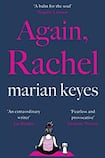
Sequels are tricky things to pull off – even more so when the original work is a 25-year-old, million-plus-seller that set a new high bar for popular fiction. Rachel’s Holiday wasn’t Marian Keyes’ first book, but it might well be her most loved, a comedy – of all things – about addiction and recovery that established her reputation as a writer of romantic stories with sharp edges and funny novels with real emotional weight.
In a recent interview, the author acknowledged the challenge of producing a follow-up to the genre-busting, modern classic. “If I do a bad job of this,” she said, “I feel like I’d be destroying not only the book I’m writing, but also the previous book.”
For fans of the original, who may have been holding their breaths, wondering could the second book measure up to the first, it’s safe to exhale now. Again, Rachel is a superb coda to the book that helped create the writer’s legacy, a serious story told with all of her trademark wit, compassion and deftness of touch.
We reconnect with Rachel Walsh 20 years on from her cocaine and pills hell. She is now moored in middle age, six years divorced, but drug-free, and working as an addiction counsellor in The Cloisters, Ireland’s very own Betty Ford Clinic.
The scenes in which we see her at work are deeply funny and equally profound set-pieces, in which she repeatedly reminds her ragbag cast of patients, with their smorgasbord of addictions, that rehab is not a reinvention heaven where you go to get your groove back.
“Kicking an addiction,” she tells the circle, “is like saying goodbye to the love of your life.”
As it happens, Rachel has done both since we last met her pre-Millennium – but not in as clear-cut a way as she tries to convince herself. “Addicts are egomaniacs,” she tells Chalkie, one of her patients. “They tend to become their own Gods,” and Rachel’s own history as an addict makes her an unreliable narrator of her story.
Her past and present collide when her ex-husband – the impossibly fit and avowedly metrosceptical Luke Costello, who considers sunscreen a girly indulgence – returns to Ireland from Colorado for his mother’s funeral with a hot, singer-songwriter girlfriend on his arm.
In the years since he walked away from their marriage, Rachel has found happiness of a sort – an “incomplete patchwork blanket” of a relationship – with the wonderfully drawn Quin. But as Keyes unfolds her plot, so Rachel’s story comes unspooled and she is forced to face painful truths about her marriage breakdown and even her recovery.
The story is told in the comic voice. It’s a voice that Keyes does so well. She is hands down the funniest writer in the business. Spoiler alert – there’s one particular scene, set in a schmancy restaurant, where the waiter lifts two cloches to reveal a starter of pleasant-smelling smoke, to be inhaled rather than eaten. It was one of several scenes that forced me to put the book face down on the table and give full vent to my laughter.
Then there are the hysterical moments we get to spend in the company of the wider Walsh family, a brilliantly colourful motley crew of characters who make Logan Roy’s brood seem uncomplicated.
But as usual with a Marian Keyes book, through the belly-laughs about activated yeast and feathery strokers and Shovel Lists and destination holidays in repurposed French legion forts, there is always the sense that an emotional sucker punch is coming. And when it does, you find yourself reading a completely different story to the one you thought you were reading a few pages earlier.
Keyes is often spoken about as the heir to Maeve Binchy, but in truth – like Binchy – she exists in a league of one. Again, Rachel is “again, Marian” at the very top of her game, showing off the skills that have made her one of the world’s most popular authors – her perfectly tuned ear for dialogue, her deadeye for detail and her empathy for people and the failings that make them human.
It’s a big book – the review copy weighed in at a hefty 570 pages – but the story never dips, a testament to her mastery as a storyteller. This is her 17th novel and undoubtedly one of her best. Given the high standards she sets for herself every time – not to mention the challenge of producing a sequel worthy of the iconic original – that is high praise indeed.

















